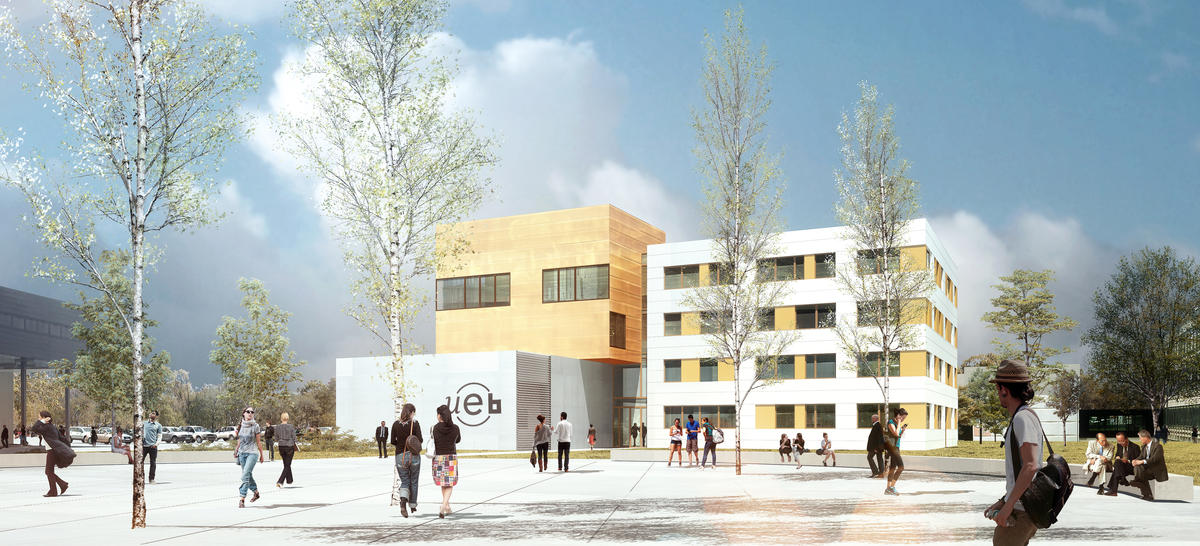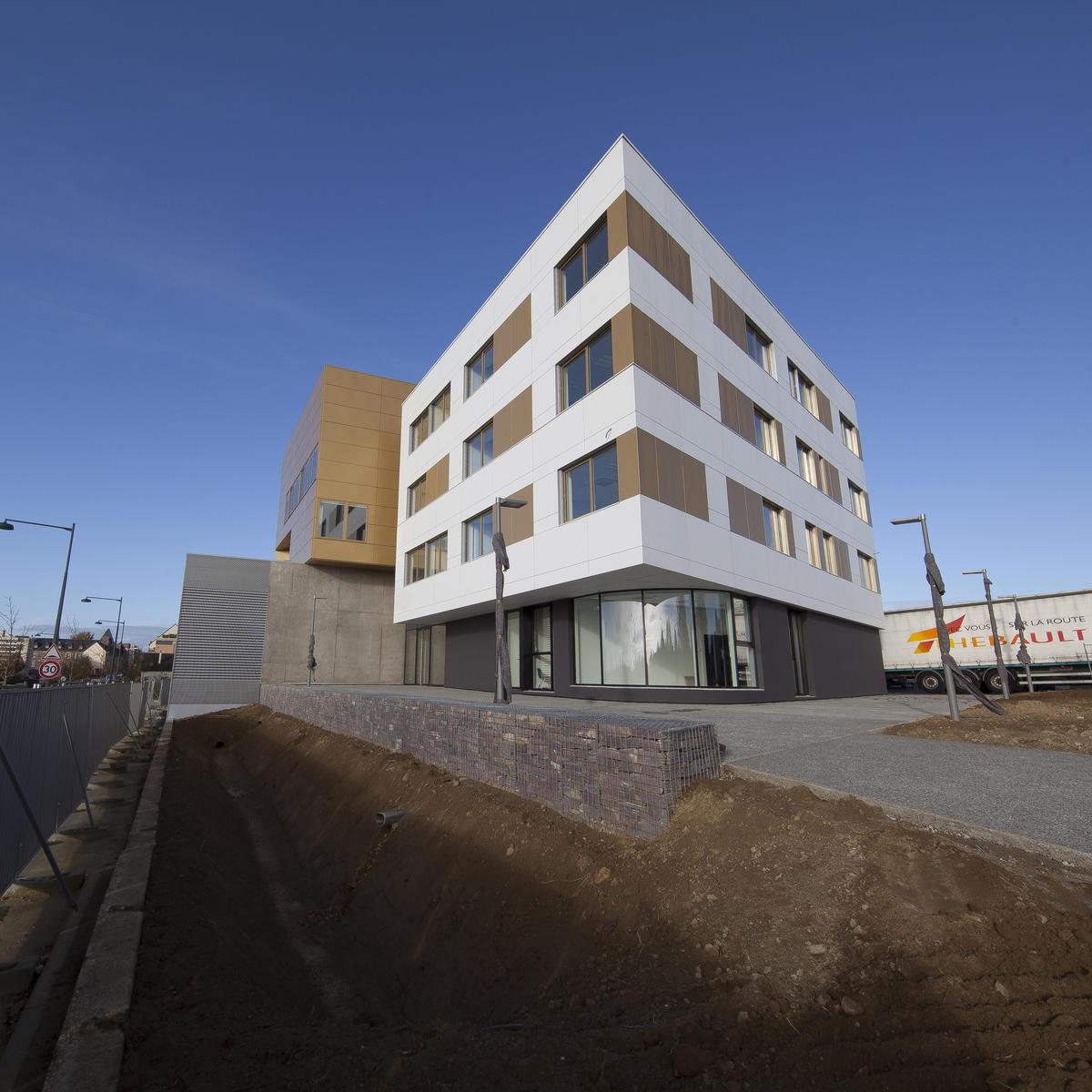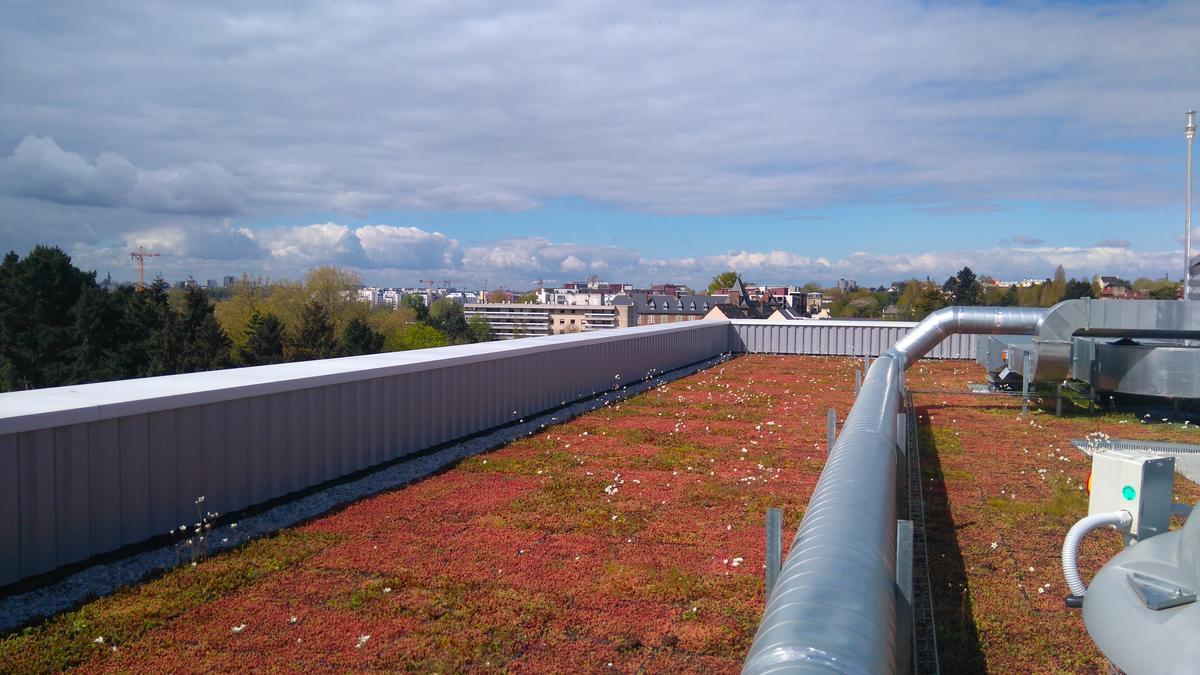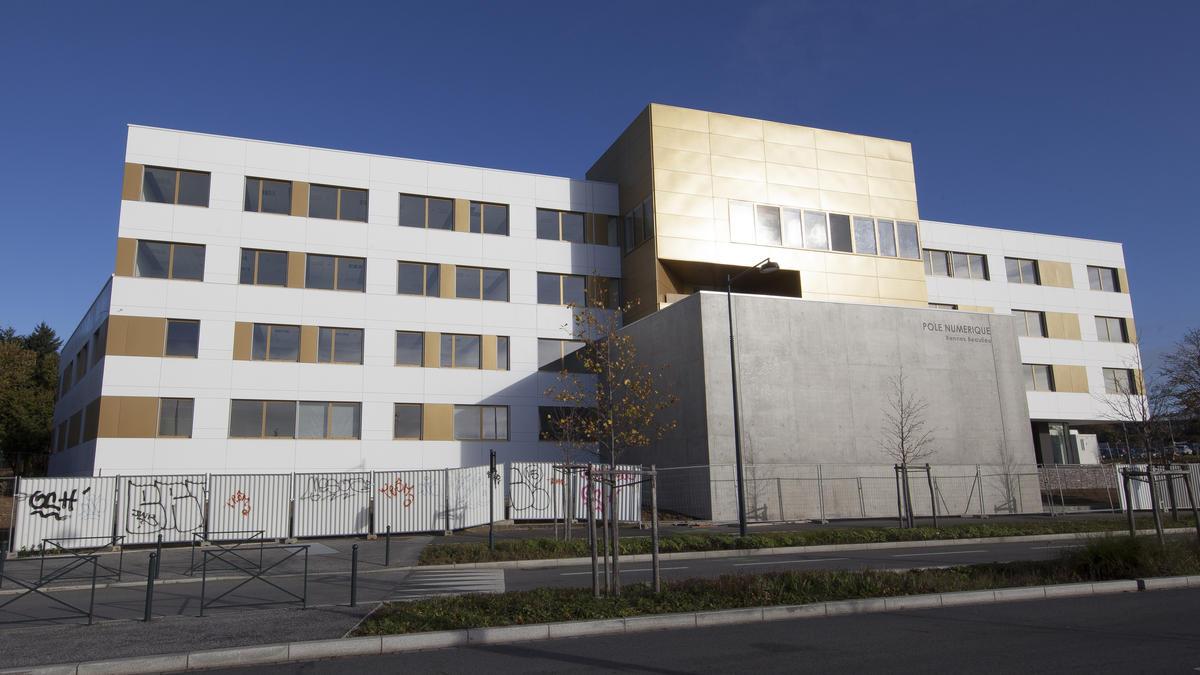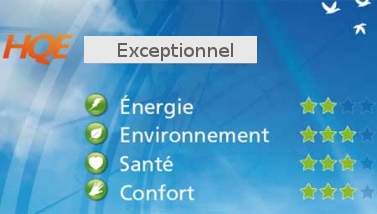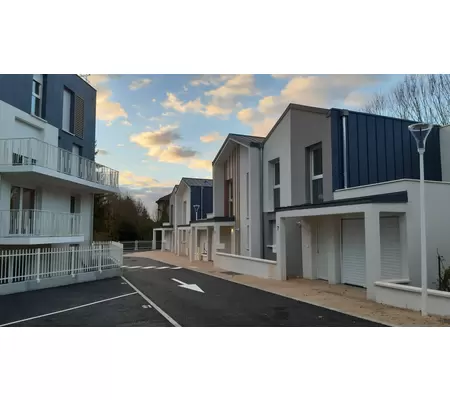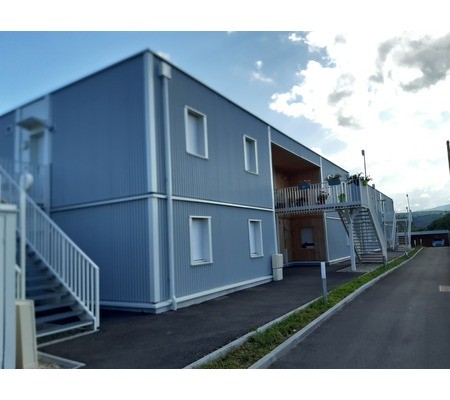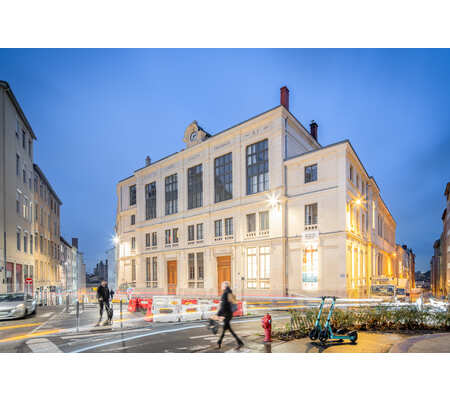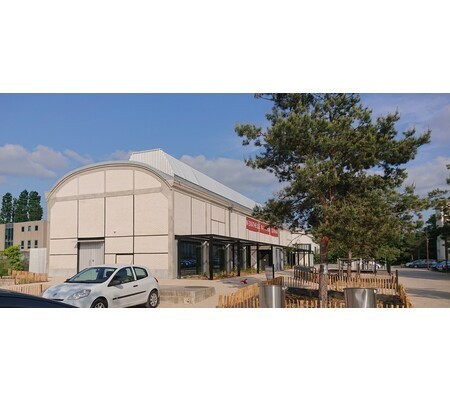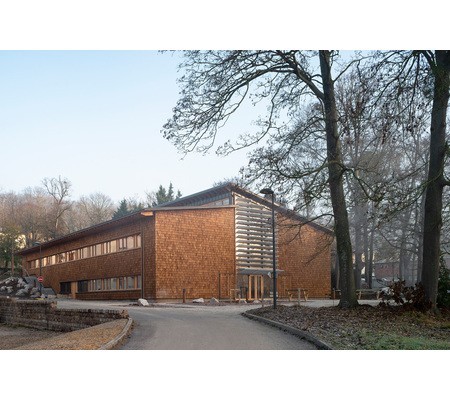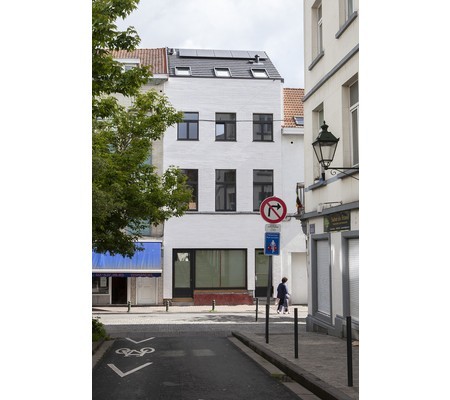UBL C@mpus: University buildings dedicated to digital
Last modified by the author on 02/01/2017 - 17:05
New Construction
- Building Type : School, college, university
- Construction Year : 2014
- Delivery year : 2015
- Address 1 - street : 35000 RENNES, France
- Climate zone : [Cfb] Marine Mild Winter, warm summer, no dry season.
- Net Floor Area : 4 002 m2
- Construction/refurbishment cost : 9 416 000 €
- Number of Pupil : 536 Pupil
- Cost/m2 : 2352.82 €/m2
-
Primary energy need
39.6 kWhep/m2.an
(Calculation method : RT 2012 )
In order to develop the digital (deployment of Collaborative Communication Infrastructure: ICC) and to do so permanently enter the campus in the digital age, the Loire Bretagne University (UBL) wished to build the following 4 buildings :
- In the Digital Cluster Rennes Beaulieu (PNRB) of 4000 m². It is situated on the Beaulieu campus in Rennes between the Avenue du Général Leclerc and driveway Jean Perrin.
- In the Digital Cluster Rennes Villejean (PNRV) of 4300 m². It is located on the site Villejean university of Rennes nearby EREVE.
- In the Digital Cluster Brest Bouguen (pN2b) of 1700 m². It is located on the campus of Bouguen Brest near the university library.
- In the Digital Cluster Brest Iroise (PNBI) of 2150 m². It is located on the BIA Technopole Brest Avenue Alexis de Rochon.
The development of the ICC is mainly effected within existing buildings. These four buildings, are not only a showcase of the project, but the only visible parts from outside the developed digital campus. They thus have a strong role not only from a functional point of view but also in terms of symbol and image to UBL C @ mpus particularly and UBL in general. The UBL hoped that the design falls within an Environmental Quality approach and hopes that the candidate obtains the certification issued by CERTIVEA H.Q.E® 2011.
The UBL brand and its environmental concern and adopt a sustainable development approach which is now recognized in all economic sectors and is reflected in the building by an approach known as "High Environmental Quality". On the other hand the four buildings are under a performance contract between the manufacturer and the UBL. The case study below focuses on the Pole Digital Rennes Beaulieu building.
Sustainable development approach of the project owner
The European University of Brittany (UEB) wanted to equip its higher education and research sites of services and high quality digital tools, building four buildings, two in Brest and Rennes in two. - Equipped with digital tele-lecture for high quality video conferencing, immersive rooms, studios ... but also designed in an ambitious environmental program, doing an exemplary project.UEB has indeed since phase program engaged in environmental quality approach to obtain the NF HQE certification issued by Commercial Building Certivéa. This approach is part of a general search of quality construction to limit building impacts and consumption of natural resources while ensuring a healthy and comfortable environment for its users.
To do this, UEB has used PPP, led by the project company Breizh Connect. Under the PPP, the company Breizh Connect project is surrounded by technical service providers for the different phases of the project, a group of design-build batimentaire composed of Eiffage Construction Bretagne, the architectural firm of Michel Remon, Egis prime contractor buildings and digital design-build group which Orange is representative. The mastery of work teams, a control layer was added. It consists of a control office Socotec, an assistant in general contractor for environmental work EGIS, an assistant in general contractor of INGEROP for technical book.
Architectural description
In the idea of bringing together four digital poles despite their geographical distance, the architect wanted the buildings, by design unit, through their frontal, their input sequence and lobby designed "uniform", prepare geographical scenery to better build the virtual gathering, the "connection" of their users.For this, he put the key piece of each building, Hall developed atrium to unite the functions it serves facing the same landscape element, a landscape element that brings together: the sky of Britain.
The architect has a plan area around a principle of any height Hall conceived as a "connector" functional units it serves. The various program elements are then connect to this center, forming a principle figure of a cross. Telephoto amphitheater form one of the branches of this figure. The entrance directly reaches the center of the figure, the lobby, along the monolith of the amphitheater. Circulation levels of lead in the hall balcony on each level to assert this desire to bring together users of each building.
The route to this entrance to the raw concrete monolith of the amphitheater, then sets
"Site layout" for each building.
The facade treatment is exactly the same for each of the four buildings:
- The figurehead of the TV amphitheater is covered in gray plain poured concrete with insulation on the inside, carefully treating the thermal bridges.
- The volume "slipped" above the amphitheater block is coated with gold metal cassettes with external insulation.
- The rest of the facades is coated panels Eternit NATURALIS clear, tinted, with exterior insulation.
The openings are of four types:
- Horizontal windows the same height in the "branches grafted onto the lobby
- Large rectangular windows on the volume "or" raised above the TV amphitheater (A vertical identical protected bay of shading / visual barrier illuminates one side of the amphitheater)
- Large curtain wall surfaces for the frame entries in buildings
- And a large window framing the sky Breton, resulting from the projection of a rectangular figure from a particular point of view when in the lobby, projected on the façade as an anamorphic Georges Rousse or Felice Varini.
Building users opinion
The occupants are already well fitting places, digital cinemas and places of conviviality and exchange. The uses are in line with expectations of the UBL. The building is very bright, thanks to floor coverings, suspended ceilings and paintings chosen but also the choice of openings and views.
If you had to do it again?
The fact that Breizh Connect site maintenance for the next 25 years to the Eiffage teams provides strong reactivated if intervention requests made by users. The cost of this maintenance is included in the total rent paid by UBL to Breizh Connect. The amount was developed by a global reasoning and cost effectively during the Competitive Dialogue PPP by many round trips between the designer and operator.
Stakeholders
Assistance to the Contracting Authority
EGIS CONSEIL
Coline BLAISON
http://www.egis.fr/organisation/egis-conseil-batimentsEnvironment project owner assistance, monitoring HQE
Contractor
BREIZH CONNECT
Guillaume DEZERT
Construction company
Eiffage Construction Bretagne
Nicolas LEPANSE
http://www.eiffageconstruction.com/home.htmlConstruction of 4 buildings.
Designer
Atelier d'architecture Michel Rémon
David LE
http://www.michelremon.com/frArchitectural design and monitoring implementation
Construction Manager
Egis Bâtiment
Benjamin KERZHERO
http://www.egis.fr/activites/batimentsTechnical design and monitoring implementation
Environmental consultancy
Orange
Digital partner
Certification company
CERTIVEA
01 40 50 29 09
http://www.certivea.frContracting method
Public Private Partnership
Energy consumption
- 39,60 kWhep/m2.an
- 60,50 kWhep/m2.an
Real final energy consumption
17,74 kWhef/m2.an
Envelope performance
- 0,90 W.m-2.K-1
- 3,34
- 0,85
Systems
- Urban network
- Water radiator
- Low temperature floor heating
- Individual electric boiler
- Water chiller
- Natural ventilation
- Free-cooling
- Double flow heat exchanger
- No renewable energy systems
Smart Building
Urban environment
- 3 400,00 m2
- 40,00 %
- 950,00
Product
Venetian blinds on weather sensor technology and management control of the building
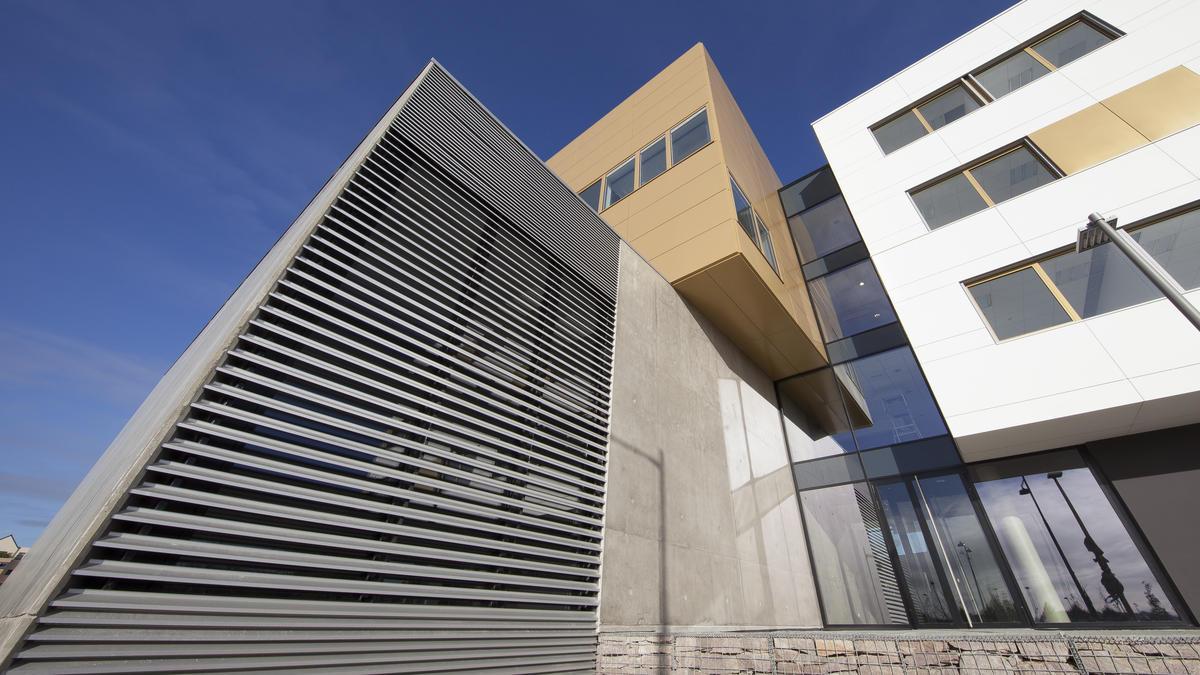
Schenker Stores
http://www.storen.ch/index.php?id=139&no_cache=1&L=1
http://www.schenkerstores.com/Second œuvre / Menuiseries extérieures
Breeze venetian blind connected to the building management and the weather station. They are controllable by the user and programmed to follow the set technical management of automatic building every hour. This reduces solar heat gain or heat loss according to the seasons.
Difficult appropriation by the users, it is necessary to teach the user to use them wisely.
Construction and exploitation costs
- 946 000 €
- 8 414 000 €
Water management
- 2 056,00 m3
Indoor Air quality
Comfort
Reasons for participating in the competition(s)
The environmental approach applied to this project is part of a research on construction quality: architectural architecture, funtional quality, technical quality, durability, modularity... The consortium develops this approach around 3 axis :
- Reducing charges for the future user of the building: a global cost study allowed to identify the most interesting technical solutions for building management. The building was tested for air-tightness and reached the French thermal regulation level minus 38%. Numerous meters are linked to the BMS, which allows centralized system management and hourly programation. Also the BMS is connected to a meteorologic probe to adapt to outdoor temperatures. To top it off, exterior solar protections keep the building from overheating and heat losses, they are controlled through meteorologic probes and also manually.
- Users' well-being: all materials in contact with outdoor air are class A or A+ to ensure healthy indoor air, light comfort is ensured through the use of very clear floor covers and wall claddings. A thermodynamic simulation was led during the design phase to guarantee thermal comfort of the users, even though there is no implemented cooling system. A CMMS allows building suers to send their requests to the facility management.
- The insertion of the building in its site, highlighting the efforts made to adapt to local constraints, the building offers very few parking lots to favor the use of public transportation, existing parking lots are permeable to rain waters, and many bike parks (94 spots) are installed and the site is connected to cycling tracks, Buses are only 150m away from the building and by 2018, a metro station will be implemented 400m away. To top it off, the roff is vegetalized.
Building candidate in the category

Bâtiment Intelligent





